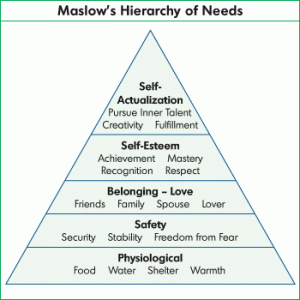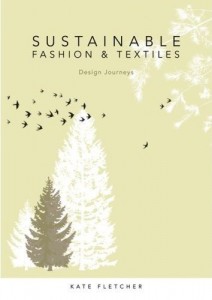Sustainable Fashion & Textiles – Design Journeys
by K. Fletcher
ISBN: 1844074811
When was the last time you shopped at Primark?
Ever had a second thought about how the clothes could be as cheap, and what human rights had to do with it?
The reality is, that far beyond human rights issues, fashion is – if considered across the whole production process, from growing the raw material up until the fashion consumer donates or bins the discarded textiles – one of the prime un-sustainable industries on the globe (see here and here).

Importantly, because clothing is so high up on the Maslow Hierarchy of needs, together with food, water and shelter, it also is likely the one consumerism-prone industry with the closest links to the consumers’ everyday lifestyle, both emotionally and practically.
Generally however, the discussion of cheap – or not quite so cheap as is the case for some house hold brands and labels – clothing and its production is usually focused around labour conditions, child labour and various other human rights issues. Hardly ever is there a spark of realisation that, in fact, the harmful impact starts much earlier, right when and where the raw fiber is being grown.
‘“Sustainable Fashion & Textiles – Design Journeys’ looks at the bigger picture of fashion and clothing within the whole sustainability debate. From virgin fiber crops and their environmental impact when grown and made into fibers and fabrics, and the role fashion has for human rights violations, right through to the impact cheap high street clothing chains and their uniformity have on diversity and textile traditions, consumerism behaviours and the (unmet) emotional needs fashion promises to meet. The author presents an industry knowledge-led critique while at the same time digging down into what fashion, or rather: clothing, means to us human beings, and what choices and options we have to full fill our need in a responsible – and fun – manner.
‘Sustainable Fashion and Textiles’ challenges the reader to question themselves about how one can still look stylish, without literally it costing the earth. The book is part handbook and part vision, consistently based on facts, statistics, research and figures that underpin the key points, yet always bearing in mind that there is a substantial ‘feel good’ factor in how we choose to dress ourselves.
The book itself is divided into 2 parts of four chapters each, covering a total of 8 chapter as starting points of a journey into the vast area of clothing and fashion related sustainability. The first four chapters focus on key phases of the textile product life cycle: materials, production, usage and waste; chapter 5 through 8 address the systemic level, and explore through case studies options and ways, from simple DYI clothes to open source fashion design, how to influence the ‘bigger picture’: Consumerism, locally and ecological lightweight options, speed of production and finally options available to make your own clothes, be it from recycled items or from scratch.
Surprisingly, the author makes it very clear that when discussing sustainable fashion, one has to truly consider all the players involved in order to give out a judgement. Just because a garment is made of natural fibre, e.g. cotton, this does not mean it is automatically sustainable as well. By walking the reader along the entire life cycle of a garment, it rapidly becomes clear that we often perceive the problem from an overly simplistic perspective:
How was the fibre grown? How much water, pesticide was used when growing it? How did it get produced? How much waste, both fabrics as well as dyes, waste water etc. was produced along the way? And when the cotton T-shirt is washed at home in the laundry machine – how often does it need to get washed? How much detergent is needed every time in doing so? What is the impact of said detergent onto the environment? And how much energy is used when washing it? How much energy is used to make a rag out of old garments, and is the total environmental cost really worth this type of recycling?
These are the kind of questions that the author opens up to the reader. The answers are sometime surprising – natural fibers are overall not necessarily as ecologically sound as we expected them to be – and make it over and over again evident that the scale of industrial production is one of the crucial variables in the global equation of sustainable production, specifically so for fashion.
This book is a thoroughly researched, fascinating, compelling, well understandable, and last but not least, beautifully illustrated read for fashion professional as well as anyone even marginally interested in fashion. It is a real eye-opener to how quickly mass-produced clothes have changed us and the planet, and there is a good chance that it will alter your perception of how you go about to buy your next set of spring clothes.
The books leaves it clear that the shear complexity of the fashion industry does not accommodate a one-solution-fits-all approach, and that innovation and an extraordinary amount of determination is indispensable to change both, the industry as well as us consumers – one design decision, one piece of clothing, one collection and one purchase at a time.
This book is available from your nearest book store as well as online from Amazon.


